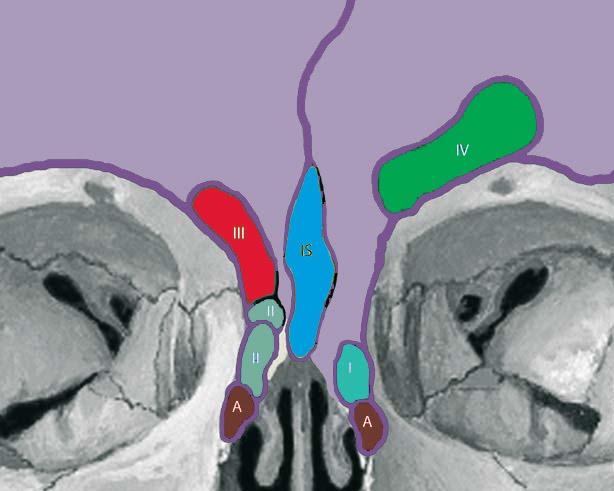Acute frontal sinusitis
Contents
Introduction:
Acute frontal sinusitis is defined as inflammation of mucosal lining of frontal sinus and it’s out flow tract of less than 3 weeks duration. The incidence ofacute frontal sinusitis is considerably lower when compared with that of maxillary sinusitis in adults and ethmoidal sinusitis in children. Early diagnosis and management of acute frontal sinusitis will go a long way in preventing development of complications.
Incidence:
Acute sinusitis commonly affects 20% of population. Acute frontal sinusitis affects about 4% of these individuals. Acute frontal sinusitis commonly affects adolescent males and young men. The age predilection is due to the fact that frontal sinuses become vascular and enlarge rapidly during 7 – 15years of life. Male predilection largely remains unexplained.
Etiopathogenesis:
Acute frontal sinusitis is commonly preceded by viral infections of upper respiratory tract. Rhino virus has been commonly implicated. Other viruses like coronavirus, respiratory syncitial virus and Parainfluenza viruses have been implicated. Viralinfections up regulate inflammatory cytokines like IL6, IL8, Tumor necrosis factor ά, histamine and bradykinin. These viruses are also known to suppress neutrophils, macrophages and lymphocytic functions inhibiting immune response. The induction of inflammatory cascade causes mucosal oedema, occlusion of sinus Ostia, impairing mucociliary clearance mechanism. This causes stasis of secretions within the frontal sinus. Mucus stasis forms anidus within the sinus for super added bacterial infections.
Host risk factors involved in the pathogenesis of acute frontal sinusitis:
These factors which predispose to acute frontal sinusitis include
1. Deviated nasal septum
2. Nasal polyposis
3. Immune deficiency states
4. Since frontal sinus is derived from the anterior ethmoidal cells these cells can cause obstruction to the outflow tract causing sinusitis. These structures include: agger nasi cells anteriorly, bulla posteriorly, supraorbital cells laterally and type I – type IV frontal cells. A series of accessory ethmoidal cells line the frontal sinus outflow tract. These cells receive various names according to their position in relation to the sinus outflow tract.
These cells include:
1. The agger nasi cell
2. Frontal intersinus septal cells
3. Suprabullar cells
4. Frontal /infundibular cells
Bent and Khunclassified frontal infundibular cells based on their proximity to agger nasicell.
Diagnosis:
Acute frontal sinusitis is a clinical diagnosis depending on the duration of symptoms, i.e. lasting for less than 4weeks. CT scans may show false positive results.
Major diagnostic criteria include:
1. Pain / tenderness over frontal sinus (tenderness can be elicited by applying pressure in the floor of the frontal sinus.
2. Head ache showing classic periodicity (More during early morning hours and gets better as the day progresses). This is due to the gravitational effects of frontal sinus drainage.
3. Nasal obstruction
4.Purulent rhinorrhoea
5. Fever
6. Hyposmia / anosmia Unless complications are suspected imaging is not a must in the diagnosis of acute frontal sinusitis.
Microbiology:
Organisms causing acute infections of frontal sinus include S. Pneumoniae, H. Influenza, and Moraxella Catarrhalis.
Aims of treatment:
1. To control infections using antibiotics
2. To reduce oedema and remove obstruction to sinus ostium facilitating drainage
3. Medical treatment will suffice. Surgery is not needed. Antibiotics chosen should be able to manage the infecting spectrum of organism.
Complications of acute frontal sinusitis:
Should be suspected in patients with:
1. Protracted symptoms with increasing severity
2. Periorbital oedema due to preseptal cellulitis
3. Painful and restricted eye movements (orbital cellulitis)
4. Neurological signs and symptoms indicate intracranial complications Meningitis is one of the important intracranial complications of acute frontal sinusitis.
Signs and symptoms of meningitis include:
1. High fever
2. Photophobia
3. Neck pain
4. Neck stiffness
5. Severe headache
6. Altered mental status
Osteomyelitis is one of the complications of acute frontal sinusitis. This is caused by direct extension of infection or by thrombophlebitis involving the diploic veins. In patients with osteomyelitis of anterior table of frontal bone may lead to formation of subperiosteal abscess which present asswelling over the forehead. This is alsoknown as the “Pott’s puffy tumor”.
Cavernous sinusthrombosis is a complication of acute frontal sinusitis. Thrombophlebitis involves the diploic veins which are valveless. The infection spreads to cavernous sinus causing thrombophlebitis. Patients with cavernous sinus thrombosis present with ophthalmoplegia, proptosis, visual loss,trigeminal nerve deficits.
Surgery is indicated in recalcitrant cases. It includes frontal sinus trephening and endoscopic decompression.
A – Agger nasi cell
I – Type I frontalcell (a single air cell above agger nasi)
II – Type II frontalcell (a series of air cells above agger nasi but below the orbital roof)
III – Type IIIfrontal cell (this cell extends into the frontal sinus but is contiguous withagger nasi cell)
IV – Type IV frontalcell lies completely within the frontal sinus
